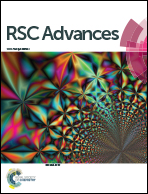Elastic properties of natural single nanofibres†
Abstract
Natural nanomaterials are becoming increasingly relevant in the context of mechanical reinforcement of a multiplicity of matrices. The elastic properties of single nanomaterials are, however, mostly unknown. By combining two different – and complementary – AFM strategies we determined the elastic properties of single clay sepiolite nanofibres to be 8.2 ± 2.5 GPa in bending mode. We took advantage of the silanol-rich sepiolite surface to covalently graft it onto a micropatterned silicon substrate to achieve an experimental setup with clearly defined boundary conditions. The determination of the elastic properties of single nanofibres was completed by the determination of the elastic moduli at other length scales and their behaviour from the macro- to the nano-scale is discussed.


 Please wait while we load your content...
Please wait while we load your content...